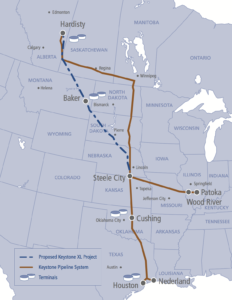Canada and America have joined forces in an endeavour that will bring new jobs to both countries, but may do so at an environmental cost.

The Keystone XL, a 1,897 kilometre transnational pipeline, stretches from Alberta to Texas, and once completed will carry 830,000 barrels of oil a day.
TransCanada Corp and their ConocoPhillips’ partners proposed a major extension to the pre-existing pipeline network in 2008, and called it the Keystone XL.
Former U.S. President Barack Obama opposed it, while Prime Minister Justin Trudeau supported Keystone since its inception.
With the recent election of Donald Trump, who supported this project during his campaign, the pipeline was officially approved transnationally.
University of Waterloo Ph.D. student Sevda Payganeh wrote her thesis, “The Keystone XL Pipeline Dispute: A Strategic Analysis,” on the Keystone XL Pipeline in 2013.
“With Obama, public image and satisfying all the parties as well as environmentalists was very important,” she said. “With Donald Trump, it is not.”
Payganeh also commented on Canada’s position.
“For Justin Trudeau, it is very important to meet the environmental factors, more than the previous Prime Minister,” she said. “But that doesn’t change the fact that they have a lot of profit in this project.”
Many parties oppose the pipeline — namely, several Indigenous groups, who Payganeh believes are directly affected.
“The First Nations had lots of conflict with Prime Minister Stephen Harper because water resources were affected, and the environment they lived in became very dirty,” she said. “Their treatment was very cruel. It was not fair.”
Payganeh said protesters’ environmental concerns are warranted.
“If we talk about the pipeline itself, it has lots of risks, such as leakage,” she said.
Payganeh said the highest environmental risk is the pollution of water resources, which include the Ogallala Aquifer in Nebraska and the Athabasca River in Alberta.
“This was the most controversial topic for environmentalists,” she said. “These two water resources are very endangered with the construction of the project.”
While the pipeline presents environmental concerns, Payganeh said crude oil could be transported more carelessly.
“Pipeline is definitely better,” she added. “Compared to railways and trucks, it is more safe.”
While the pipeline method is preferred, Payganeh said there is room for improvement and urges UW students to get involved and apply their knowledge and resources.
“It has lots of potential for different fields of study,” she added. “For example, to design a pipeline that has the least leakage, and work on methods that produce less pollution and produce better oil.”
Following the approval of the pipeline by the Trump administration in March, Imprint contacted Natural Resources Canada communications officer Tania Carreira Periera, who said the Canadian government believes the environment and economy go hand-in-hand.
Periera said the Canadian portion of the Keystone XL was approved in 2010 with conditions that target safety and environmental protection, including monitoring greenhouse gas emissions and indigenous concerns.
Periera also cited Canadian job growth as a reason for the government’s support.
This mirrors a position of Payganeh’s, who predicts short-term economic benefits.
“Economic effects are always high with these projects,” she said. “However, in the long-term with climate change, it’s more serious.”

































